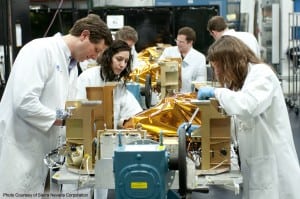Latest News
[Via Satellite 03-04-2014] Small satellite trends are shifting away from one-time stints and moving toward more regular use in a constellation setting. Sierra Nevada Corporation Vice President of Business Development John Roth told Via Satellite that the company has noticed an increase in the desire to mass produce low-weight satellites. While currently working on Orbcomm’s new constellation of communications satellites (OG2), several potential customers have come to the company with ideas about constellations.
“We’ve probably had a half a dozen companies in the last year or two come to us with ideas about small satellite constellations that they would like to do,” said Roth. “We have non-disclosures so I can’t tell you who the companies are, but most of them are either commercial startups that have some funding already or are working with us to try to get funding from investors to get their concepts off the ground.”
According to Roth, many of these companies were inspired by the strategy Skybox Imaging used, where a small number of satellites are used for technology demonstration purposes in order to draw the attention of investors. Then, after obtaining enough capital, they can quickly move into a production phase.
“We are seeing a number of companies with that same model coming to us and asking us to help support concepts and put together some budgets that they can take to the investor community,” said Roth. “I would think in the next few years you are going to see other commercial companies emerging in the small satellite range.”
The purposes of these satellites vary and are designed to target different niche applications. Some are dedicated to Earth observation missions, others are looking into bands other than electro-optic, while others, such as the joint Taiwan-U.S. Formosat constellation, are looking at weather prediction and other meteorological purposes. The markets represented cover a range of addressable issues.
“There is a trend toward miniaturization in LEO for satellite applications, said Stéphane Gounari, senior analyst at NSR. “[And] not just CubeSats, it is for the whole range. Cube/NanoSats are the extreme … [but] there is a reason why for some applications you have to use big satellites, because you cannot fulfill certain requirements with small satellites.”
Some satellite-enabled services require larger satellites, which are not following the trend toward smaller sizes. Iridium Next satellites, for example, need to have a very strong Effective Isotropic Radiated Power (EIRP) to connect with handsets, which brings about greater power requirements and drive up the size. According to Gounari, communication satellites are largely missing this miniaturization trend.
“Communications satellites tend to grow in mass,” he explained. “Orbcomm’s satellites are still small but the new constellation is way bigger than the first one (155kg from 45kg). Iridium, Globalstar and O3b start from a higher point but are following the same trend. In that sense, small satellites are used for communications purposes, but the success of the application drives them toward higher mass.”
Orbcomm’s small communication satellites have grown in size, but they are still small, which makes them a unique case. The defining change for small satellites remains that they are serving long-term purposes today, and are expected to play a permanent role going forward. Satellites are polarizing to become either larger by necessity or smaller by opportunity. Based on factors such as launch availability, personnel and financing, the preference toward small satellites has become very noticeable on a global scale.
“Worldwide, there is huge interest in small satellites,” said Roth. “Most countries don’t start out with a U.S.-sized budget for multi-thousand kilogram satellites. Interested countries are not just looking for a first-satellite foothold, they’re looking for space capabilities over the long-term but in affordable programs.”
“In terms of market rate … internationally there is a growing interest in small satellites, though there remains a strong interest in the U.S.,” added Gounari.
For now, Sierra Nevada Corp. remains focused on its current contract for 18 satellites with Orbcomm. The first six are scheduled to launch on a SpaceX Falcon 9 rocket in April, with the remaining 12 going up on a second launch later in the year. Benefits like the ability to rapidly install an entire constellation continue to drive satellite operators to make smaller spacecraft when possible. According to Roth, this is a desire satellite manufacturers should be pay a healthy amount of attention.
“I really see growth all the way from CubeSats up to 500 kg size,” he said. “That’s going to be an expanding market for a while.”
Get the latest Via Satellite news!
Subscribe Now
